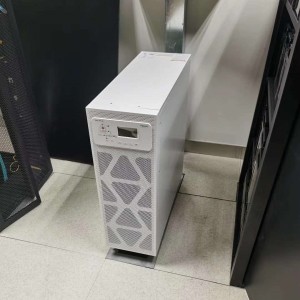- 产品
- 详情
- 推荐
收藏
¥10500.00
5-9台
¥10000.00
≥10台

产品规格
颜色: 黑色
科迪批发EMERSON/艾默生UPSGXT4-3000RT230U 2600/2700/3000/3000VA
Liebert® GXT4™
500-3000VA Rack-Tower
GUIDE SPECIFICATIONS
艾默生VERTIV維谛UPS电源蓄电池华北营销中心,支持渠道产品报价,产品方案,产品报备,产品参数咨询等服务.
1.1 SUMMARY
This specification shall define the electrical and mechanical characteristics and requirements for a continuous-duty, single-phase, solid-state uninterruptible power system (UPS). The UPS shall provide high-quality AC power for sensitive electronic equipment loads.
1.2 STANDARDS
The UPS shall be designed in accordance with applicable sections of the current revision of the following documents. Where a conflict arises between these documents and statements made herein, the statements in this specification shall govern.
120 and 208V Nominal Units
· Listed to UL Standard 1778, 4th Edition; and c-UL Listed
· CSA 22.2 No. 107.1
· ANSI C62.41, Category A, Level 3
· IEC 61000-3-2
· EN62040-2
· EN61000-4-2
· EN61000-4-3
· EN61000-4-4
· EN61000-4-5
· EN61000-4-6
· FCC Part 15, Class A
· ISTA Procedure 1A/1E
· RoHS2 (6 by 6) Compliant
· REACH and WEEE Compliant
230 Volt Nominal Units
· EN 62040-1:2008
· TUV/GS and CE compliance mark
· EN50091-1-1
· EN50091-2, Class A
· EN50082-1
· EN62040-2, 2nd Ed, Category C2
· EN61000-4-2
· EN61000-4-3
· EN61000-4-4
· EN61000-4-5
· EN61000-4-6
· EN61000-3-2
· ISTA Procedure 1A/1E
· RoHS2 (6 by 6) Compliant
· REACH and WEEE Compliant
· Listed to UL Standard 1778, 4th Edition; and c-UL Listed (700, 1000, and 3000VA models only)
1.3 SYSTEM DESCRIPTION
1.3.1 Modes of Operation
The UPS shall be designed to operate as a true on-line double-conversion system in the following modes:
A. Normal - In normal operation incoming AC power shall be fed to the input power factor corrected (PFC) rectifier that converts the AC power to DC power for the inverter. In this mode, power shall also be derived from utility power for the battery charger. The inverter shall derive DC power from the PFC rectifier to regenerate filtered and regulated AC sinewave power for the connected load. The unit shall begin charging the battery once the UPS is connected to utility power, regardless of whether the UPS is ON or OFF. In the event of a utility outage or severe abnormality (sag or swell), the inverter shall support the connected load from battery power until the battery is discharged or the utility power returns, whichever occurs first.
B. Battery - Upon failure of utility / mains AC power, the critical AC load shall be supplied by the inverter, which obtains power from the battery. There shall be no interruption in power to the critical load upon failure or restoration of the utility / mains AC source.
C. Recharge - Upon restoration of utility / mains AC power, after a utility / mains AC power outage, the input converter shall automatically restart and resume supplying power to the inverter and the battery charger to recharge the battery.
D. Automatic Restart - Upon restoration of utility / mains AC power, after a utility / mains AC power outage and complete battery discharge, the UPS shall automatically restart and resume supplying power to the critical load and the battery charger automatically recharges the battery. This feature shall be capable of being disabled by the user.
E. Bypass - The integral bypass shall perform an automatic transfer of the critical AC load from the inverter to the bypass source, in the event of an overload, PFC failure, internal over temperature, DC bus overvoltage or inverter failure conditions.
F. ECO – The UPS shall allow the user to enable and place the UPS in ECO mode of operation to reduce electrical consumption. The ECO mode operation shall be an Active type, whereas the UPS will power the connected equipment through the bypass path and the UPS inverter shall be on and operating at no load in order to stay synchronized to the bypass to ensure rapid transfers to inverter power when input power falls outside of the user customizable parameters. The UPS shall also have a user customizable requalification time that input power must remain within the ECO mode parameters before transferring back to ECO operation. This is to minimize the number of transfers between bypass and inverter.
1.3.2 Design Requirements
A. Voltage
Input/output voltage specifications of the UPS shall be:
Input
· 120V units: 0 - 140VAC, 50/60Hz, single-phase, 2-wire-plus-ground.
· 208V units: 0 - 280VAC, 50/60Hz, single-phase, 2-wire-plus-ground.
· 230V units: 0 - 280VAC, 50/60Hz, single-phase, 2-wire-plus-earth.
Output
· 120V units: 120VAC (user configurable: 110V, 115V, 120V, 127V) ±3%, 50/60Hz, single-phase, 2‑wire-plus-ground.
· 208V units: 208VAC (user configurable: 208V, 220V, 230V, 240V) ±3%, 50/60Hz, single-phase, 2‑wire‑plus-ground.
· 230V units: 230VAC (user configurable: 220V, 230V, 240V) ±3%, 50/60Hz, single-phase, 2‑wire‑plus‑earth.
B. Output Load Capacity
Specified output load capacity of the UPS shall be:
· 500VA/450 Watts at 0.9 lagging power factor.
· 700VA/630 Watts at 0.9 lagging power factor.
· 1000VA/900 Watts at 0.9 lagging power factor.
· 1500VA/1350 Watts at 0.9 lagging power factor.
· 2000VA/1800 Watts at 0.9 lagging power factor.
· 3000VA/2700 Watts at 0.9 lagging power factor.
C. Internal Battery
The UPS shall utilize valve-regulated, non-spillable, lead acid cells.
D. Reserve Time
· 500VA: 17 minutes
· 700VA: 11 minutes (120V or 230V)
· 1000VA: 7 minutes (120V); 3 minutes (230V)
· 1500VA: 6 minutes (120V or 230V)
· 2000VA: 3 minutes (120V or 230V)
· 3000VA: 3 minutes (120V or 208V or 230V)
These times shall be at full load with ambient temperature of 77°F (25°C) with resistive loading.
E. Battery Recharge
The UPS shall contain a three-stage battery charger designed to prolong battery life. Recharge time for UPS internal batteries shall be 5 hours (for 500, 700, 1000, 2000, and 3000VA models) and 6 hours (for 1500VA models) to 90% capacity after a complete discharge with full load connected.


1.3.3 Performance Requirements
1.3.3.1 AC Input to UPS
A. Voltage Configuration: The UPS shall incorporate a variable input voltage window feature that shall operate at the values in the following table, without drawing power from the batteries.
Load Level | 500-1000 VA 120 VAC Input Voltage | 1500-3000 VA 120 VAC Input Voltage | 3000 VA 208 VAC Input Voltage | 700-2000 VA 230 VAC Input Voltage | 3000 VA 230 VAC Input Voltage |
| 90 VAC | 102 VAC | 177 VAC | 177 VAC | 196 VAC |
90% | 86 VAC | 96 VAC | 168 VAC | 168 VAC | 184 VAC |
80% | 81 VAC | 90 VAC | 159 VAC | 159 VAC | 173 VAC |
70% | 77 VAC | 84 VAC | 150 VAC | 150 VAC | 161 VAC |
60% | 73 VAC | 78 VAC | 142 VAC | 142 VAC | 150 VAC |
50% | 69 VAC | 72 VAC | 133 VAC | 133 VAC | 138 VAC |
40% | 64 VAC | 66 VAC | 124 VAC | 124 VAC | 127 VAC |
30% | 60 VAC | 60 VAC | 115 VAC | 115 VAC | 115 VAC |
B. Frequency: UPS shall auto-sense input frequency when first powered up and shall operate within the following frequency specifications. UPS shall be capable of cold start with default frequency of 60Hz (120VAC and 208VAC units) and 50Hz (230VAC units). Once started the frequency operating window shall be 40-70Hz.
Three frequency settings shall be available in the Liebert GXT4 Configuration program: Auto frequency sensing (factory default setting), 50Hz frequency conversion and 60Hz frequency conversion.
C. Input Power Factor: >0.99 lagging at rated load.
D. Input Current reflected distortion: 5% THD typical.
E. Input Current Ratings
UPS Model # | 120VAC Units | 230VAC Units | 208VAC Units |
500RT | 4.2A | N/A | N/A |
700RT | 5.8A | 2.9A | N/A |
1000RT | 8.3A | 3.9A | N/A |
1500RT | 12A | 5.9A | N/A |
2000RT | 16A | 7.8A | N/A |
3000RT | 24A | 11.7A | N/A |
3000RT208 | N/A | N/A | 12.9A |




科迪批发EMERSON/艾默生UPSGXT4-3000RT230U 2600/2700/3000/3000VA
¥ 10000.00 ~ ¥ 10500.00
¥ 10000.00
10000台可售

询价单发送成功~


























